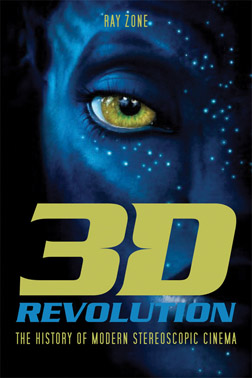

In 2009, Avatar, a 3-D movie directed by James Cameron, became the most successful motion picture of all time, a technological breakthrough that has grossed more than $2.5 billion worldwide. Its seamless computer-generated imagery and live action stereo photography effectively defined the importance of 3-D to the future of cinema, as well as all other currently evolving digital displays. Though stereoscopic cinema began in the early nineteenth century and exploded in the 1950s in Hollywood, its present status as an enduring genre was confirmed by Avatar's success.
3-D Revolution: The History of Modern Stereoscopic Cinema traces the rise of modern 3-D technology from Arch Oboler's Bwana Devil (1952), which launched the 50s 3-D boom in Hollywood, to the rapidly-modernizing 3-D industry today. Ray Zone takes a comprehensive approach that not only examines the technology of the films, but also investigates the business, culture, and art of their production. Influencing new generations of filmmakers for decades, the evolution of 3-D cinema technology continues to fill our theaters with summer blockbusters and holiday megahits.
Ray Zone is an award-winning 3D artist, speaker and film producer. He is the author of Stereoscopic Cinema and the Origins of 3-D film, 1838-1952 and lives in Hollywood. California.
"It is indeed rare to come across a book that captures a revolutionary movement in film history as well as this tome has. In documenting the history of 3-D motion pictures, from the inception of film making up through the latest digital 3-D technology, Zone has produced an extremely significant legacy."
--Susan Pinsky, proprietor of Reel 3-D Enterprises
"Ray Zone is uniquely positioned to write 3-D Revolution. As a dedicated historian and writer, he has witnessed the advancement of stereoscopic cinema as one of its closest observers, and living in Los Angeles at the heart of commercial movie making has given him access to every development and the people involved. His attention to detail is impeccable and his ability to represent the many conflicting perspectives on stereoscopic cinema with fairness and balance is one of his greatest skills."
--Phil Captain 3-D McNally
"Ray Zone is your expert guide to the third dimension. In this fascinating book, we are taken on a journey back to the early days of cinema when experiments in stereo photography opened up entirely new worlds to audiences across the globe. Ray's informed and thoughtful insight into the characters past and present who devised the amazing inventions makes this an incredible adventure through an important part of our cinematic history."
--Buzz Hays, S3D Producer and Consultant at True Image Company
"Zone has been everywhere, knows everyone and has seen everything. 3-D Revolution will be an indispensable reference for students, scholars, journalists and anyone who wants to really understand not just what happened with 3-D, but how it happened."
-- David S. Cohen, technology columnist, Variety
ISBN: 9780813136110
Publication Date: August 5, 2012
Binding: Hardbound with Dust Jacket
Pages: 441
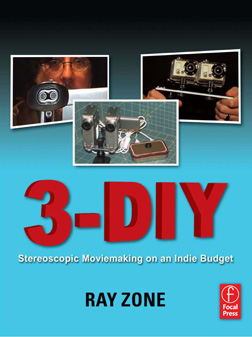
A must-have read for anyone looking to take their independently-produced film or video into the 3rd dimension. The text features technical, practical, and inspirational insight from the visionaries who've been producing 3D film and video for decades, not just in the recent past. They offer low-cost techniques and tricks they've been implementing themselves for years. A variety of styles are discussed, from full CG to time lapse - even a film made during a freefall skydive jump!
The filmmakers discuss
* Options for on-set playback
* Preparing for final playback in various formats
* Adapting existing technology to your needs
* Post production software choices
* Working with computer graphics in 3D
This book includes 3D glasses and a companion YouTube channel featuring the work of the filmmakers featured in the book (which you can view in 3D with the glasses), as well as the opportunity for you to upload your own videos for critique and feedback from the author and others.
Eric Kurland: Shooting 720p 3-D with two Canon T-X1 Consumer Cameras
Celine Tricart: Stereoscopic Storytelling
Alexander Lentjes: Creating a 3D Homage to Bad Films
Eric Deren: Shooting 3D Video in Freefall
Sean Isroelit and Jeff Amaral: Producing 3D with High Tech Tools and Talents
Jo Eldoen and Karl Bryhn: Creating Abstract CG Animation on the Z-Axis
John Hart: Shooting Time-Lapse 3D Movies with Digital Still Cameras
Ryan Suits: Shooting Black Light in 3D
Santiago Caisedo: Inventing 3D Movies from Mixed Toolsets
Stephen Les: Editing with Cineform Neo3D
Takashi Sekitani: Getting Creative with Canine POV and Hyperstereo in 3D
Zoe Beloff: Creating Apparitions in 3D
Bernard Mendiburu and Eric Kurland: The World's First 720p International Skype 3D
Tommy Tripodes: Building a 3D System in Film School
Tom Koester: Doing It All in 3D
Ray Zone: Making 3D Movies with a Stereo Club
John E. Hart: Jesting with Urban Legends in the Short 3D Film
Ron Labbe: From the Computer Monitor to the Giant Screen
Phil McNally: Making a Short Film to Get a Job in Hollywood
John Rupkalvis: Making 3D Camera Systems Smaller
Perry Hoberman: Performing and Inventing 3D
Stephen Gibson: Shooting and Finishing a 3D Feature Film on the Desktop
Al Razutis: A Complete 3D Artist
ISBN: 9780240817071
Publication Date: March 2012
Paperbound
Pages: 376
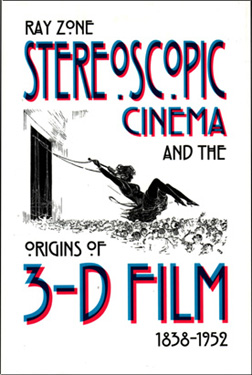
Those who think that 3-D film started in the 1950s with leaping lions and flying saucers may be in for a surprise. Even many educated film industry professionals and scholars are ignorant of the true origins of 3-D. When motion pictures were invented in the late 19th century, the stereographic image was already at the height of its popularity, and by the time of the 3-D film boom in the 1950s, the technology had been in use for over a century. The years between the invention of stereoscopy and the widespread success of 3-D films were a time of prolific breakthroughs and innovation and, disproportionately, a period under-addressed by stereoscopic scholarship.
Stereoscopic Cinema and the Origins of 3-D Film, 1838-1952 is an account of the revolution in technology and thought that gave birth to the proliferation of 3-D films in the 1950s. Ray Zone, a 3-D artist and expert in stereoscopy, takes the reader on a voyage of stereo discovery into the rich history of the inventors and technologies that lead to the revolution evidenced in such popular 3-D films as Man in the Dark and House of Wax. He demonstrates how the development of stereoscopic technologies influenced movies more broadly, by showing the interaction between pioneers in both fields.
Zone chronicles the evolution of stereoscopic cinema from 1838 to 1952 by threading together prominent inventions of the period. Charles Wheatstone's introduction of his stereoscope in 1838 let hundreds of inventors to turn their energy towards the promise of stereoscopic photography and film in the decades that followed. Zone looks at the popular inventions, such as Stereoview cards, Thomas Edison's Kinetoscope, magic lanterns, anaglyphs, and stereoscopic video cameras, alongside many others that never caught on, to chart the progression of the technology that lead to the projection of the first stereoscopic feature film, The Power of Love, in 1922.
Throughout the following decades, filmmakers continued to search for new ways to capture moving image in 3-D and show them on the big screen. The Festival of Britain in 1951, designed to showcase new innovations in art and science, featured new stereoscopic films shown accompanied by stereophonic sound for the first time, including The Magic Box, A Solid Explanation, The Distant Thames, Now Is the Time (To Put on Your Glasses), and Around is Around. The tremendous success of these films sparked the interest of filmmakers and cinemas across the Atlantic and with the 1952 release of Arch Oboler's innovative film, Bwana Devil, the 3-D craze was born.
The public's fascination with the heightened realism and powerful visual allure of stereoscopic films continues today as filmmakers explore new possibilities using current, advanced technology. Stereoscopic Cinema and the Origins of 3-D Film, 1838-1952 is an exhaustive account of the conception and development of a technology that continues to influence the movies, television, and computer animation today.
ISBN: 978-0-8131-2461-2
Publication Date: December 7, 2007
220 pages
Binding: Hardbound with dustjacket
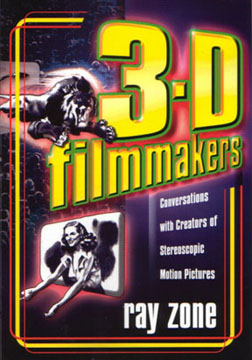
Although numerous books about conventional filmmaking exist, none has solely addressed the challenges and production requirements of making stereoscopic motion pictures. Until now. Stereographer and film historian, Ray Zone, presents the insights of twenty-one professionals who have worked in this specialized field.
In this unique collection of interviews, Zone explores the art and craft of 3-D filmmaking with producers, screenwriters, directors, and cinematographers. The interviews range from a discussion with Arch Oboler - producer of Bwana Devil, the 1952 feature that triggered the "boom" of 3-D films - to producers and cinematographers who have worked with single-strip 3-D film production in the 1970s and '80s, 3-D films in theme parks, current IMAX films, and the new and still evolving format of digital 3-D cinema.
These interviews provide an unprecedented look at the unique challenges of producing stereoscopic motion pictures. Over five decades of this unique medium are covered, and will interest aspiring filmmakers, stereo photography enthusiasts, cinema buffs, devotees of popular culture, and film historians.
ISBN: 0-8108-5437-6
ISBN-13: 978-0-8108-5437-6
Publication Date: February 2005
192 pages
Binding: Paper
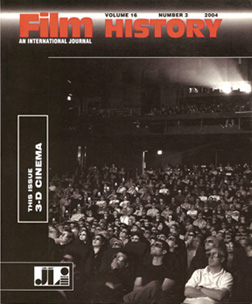
The inspiration for this special issue of Film History was the World 3-D Expo held at the Egyptian Theater in Los Angeles from 12-21 September 2003. In a period of just ten days, 33 feature films and 21 short subjects were screened, most of them dating from the height of the 3-D craze of 1953 and early 1954. The Expo was organized by Jeff Joseph of SabuCat Productions (with some assistance from 3-D historians Dan Symmes and Bob Furmanek) and made many 3-D films available for public view for the first time in fifty years.
A handful of 3-D revivals have taken place over the years, but nothing of this scope had ever been attempted before. For the series, SabuCat installed a new silver screen in the Egyptian (silver screens are necessary to maintain proper polarization of the light from the projectors) and modified the theater's Christie projectors for synchronized, dual system projection. It was a rare event that this issue of Film History celebrates. The issue begins with a photo-essay of the Expo, and includes a descriptive account by Rick Mitchell, an essay on Kiss Me Kate by William Paul, a discussion of the 3-D cinematography of Dial M for Murder by Sheldon Hall and a 3-D Filmography by Gary Palmer.
3-D historian Ray Zone contributes an account of the development of dual-band 3-D cameras during the 1950s, tracing these developments back to the work of Loucks and Norling in the 1930s. Zone reviews the various dual camera systems developed between the early 1930s and the early 1950s and pays special attention to the 1951 Festival of Britain as an important precursor to the success of Natural Vision and other systems in Hollywood in the early 1950s. Zone explores the development of dual camera systems in terms of the various systems' solutions to problems related to interaxial spacing (i.e., spaces between the lenses) and convergence (the angle of each lens in relation to the other).
-- John Belton, Associate Editor
ISBN: 0892-2160
Volume 16 Number 3
Publication Date: 2004
122 pages
Binding: Paper
